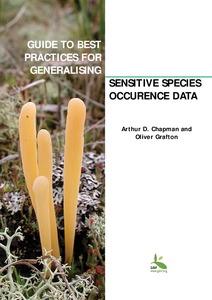| dc.contributor.author | Chapman, Arthur D. | |
| dc.contributor.author | Grafton, Oliver | |
| dc.date.accessioned | 2018-12-20T19:08:57Z | |
| dc.date.available | 2018-12-20T19:08:57Z | |
| dc.date.issued | 2008 | |
| dc.identifier.citation | Chapman, A.D. and Grafton, O. (2008) Guide to best practices for generalising sensitive/primary species occurrence-data. Version 1.0. Copenhagen, Denmark, Global Biodiversity Information Facility, 27pp. DOI: http://dx.doi.org/10.25607/OBP-168 | en_US |
| dc.identifier.isbn | 87-92020-06-2 | |
| dc.identifier.uri | http://hdl.handle.net/11329/605 | |
| dc.identifier.uri | http://dx.doi.org/10.25607/OBP-168 | |
| dc.description.abstract | The unprotected distribution of Sensitive Primary Species Occurrence Data (for example the
exact localities of rare, endangered or commercially valuable taxa) has been a concern of the
GBIF Secretariat since its beginning. In early 2006, GBIF initiated a process to address this
issue, especially in relation to data to be shared through the GBIF network and made visible
through the GBIF Data Portal.
A review of current approaches for obscuring or generalising such data was initiated in
February 2006 and an on-line survey conducted through Survey Monkey1
. A separate report
on the results was made available via the GBIF Web site2
in early June 2006 (Chapman
2006). An experts’ workshop was then held in early March 2007 that focussed on the various
technical issues involved (Chapman 2007a).
A final report on Dealing with Sensitive Primary Species Occurrence Data was developed
following these processes and discussions, and was presented to GBIF in April 2007
(Chapman 2007b). It is available via the GBIF Web site. This report made a number of
recommendations, and many of these are included in this document.
The final step in this process has been to develop a Guide to Best Practices. This document
should be seen as an overriding guideline for institutions, data providers and GBIF Nodes to
use to develop their own in-house guidelines. Organisations and institutions should produce
their own internal document that incorporates the practices outlined in this document and
related documents such as the Guide to Best Practices in Georeferencing (Chapman and
Wieczorek 2006) and incorporate them into their own working environment.
It is also important to understand the possible impact that approaches for restricting sensitive
data may have on biodiversity science and, while restricting the availability or resolution of
certain data, not overly restricting the uses to which the data may be put. For that reason, a set
of principles are elucidated below. Key among these is the need to make biodiversity
information freely available wherever possible, in the interests of science, the environment
and the biodiversity itself.
Two issues that this document has not covered, because they will need further discussion and
agreement before robust recommendations can be made, are the issues of the privacy of
living individuals and the development of Data Sharing and Data License Agreements. Both
of these issues have legal implications and vary considerably from jurisdiction to jurisdiction.
Recommendations were made in the Report on Dealing with Sensitive Species Occurrence
Data (Chapman 2007) for GBIF to further explore these issues | en_US |
| dc.language.iso | en | en_US |
| dc.publisher | Global Biodiversity Information Facility | en_US |
| dc.subject.other | Species diversity | en_US |
| dc.subject.other | Sensitive data | en_US |
| dc.subject.other | GBIF | en_US |
| dc.title | Guide to best practices for generalising sensitive/primary species occurrence-data. Version 1.0. | en_US |
| dc.type | Report | en_US |
| dc.description.status | Published | en_US |
| dc.format.pages | 27pp. | en_US |
| dc.description.refereed | Refereed | en_US |
| dc.publisher.place | Copenhagen, Denmark | en_US |
| dc.subject.parameterDiscipline | Parameter Discipline::Biological oceanography::Biota abundance, biomass and diversity | en_US |
| dc.description.currentstatus | Current | en_US |
| dc.description.sdg | SDG14A | en_US |
| dc.description.bptype | Best Practice | en_US |
| dc.description.bptype | Guide | en_US |
| obps.contact.contactemail | www.gbif.org | |
| obps.resourceurl.publisher | https://www.gbif.org/document/80512 | |
 Repository of community practices in Ocean Research, Applications and Data/Information Management
Repository of community practices in Ocean Research, Applications and Data/Information Management
